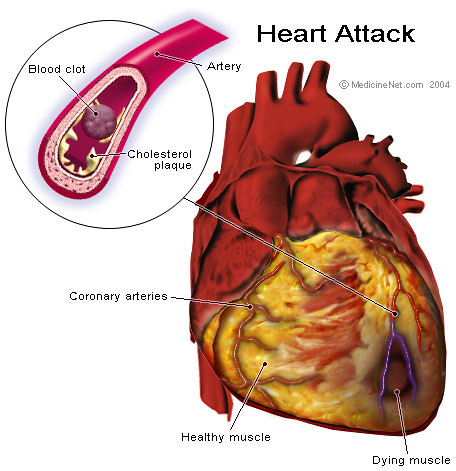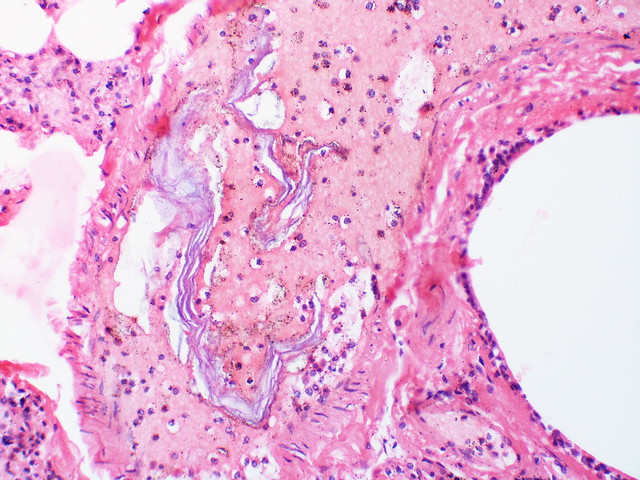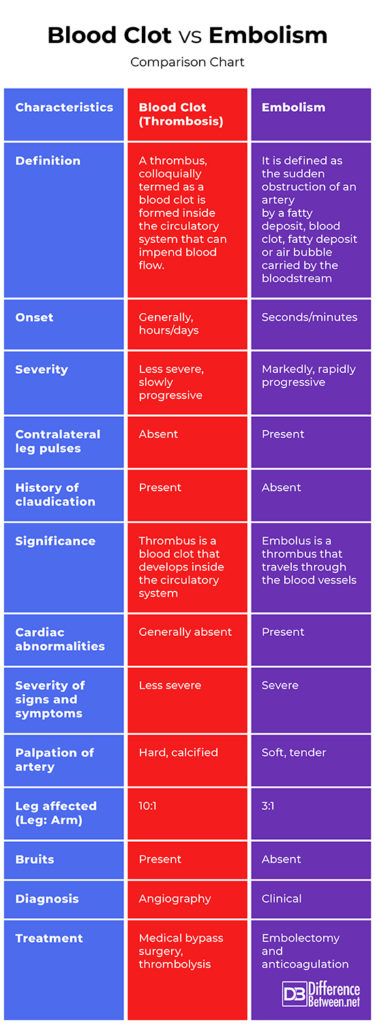Difference Between Blood Clot and Embolism
What is Blood Clot (Thrombosis) and Embolism?
Both embolus and thrombus mean – a blood clot. Both comprise of fat, platelets, a tumor, amniotic fluid, a tumor, air or foreign substances. Both blood clot and embolus occur inside the circulatory system.
Thrombosis (blood clot formation) and embolisms are different conditions. However, one thing common in them is that they both are characterized by a blood clot. Blood clot (thrombus) develops in a blood vessel. As a result, there is a reduction in flow of blood through the vessel. In embolism, embolus (a piece of a blood clot), or other bodily or foreign substance becomes lodged in a blood vessel. This results in obstructing the blood flow.

Blood Clot
A blood clot or a thrombus is a clump of blood, adheres to the vessel wall that has changed from a liquid to a gel-like or semisolid state.
2 main complications associated with blood clots or thrombosis are pulmonary embolism and post-thrombotic syndrome. The latter happens when a patient develops long-term symptoms like ulcers, rashes, pain, and swelling.

Embolism
Embolus is an intravascular clot that floats in the blood.
Complications include abnormal and irregular heartbeat, cardiac arrest and sudden death, pulmonary infarction (death of part of the lung), shock, pulmonary hypertension and paradoxical embolism.
Difference between Blood Clot and Embolism
Definition
Blood Clot
A stationary blood clot on vessel wall. A blood clot has a stationary mass.
A blood clot develops as a result of injury to a body tissue or a blood vessel. The development of blood clots is induced by several conditions like cigarette smoking, high cholesterol, high blood sugar, malignancy (cancer), obesity or overweight, anxiety and depression, and sedentary lifestyle.
Embolism
A mobile or floating clot, which often is a fragment of a thrombus. An embolus has a free-floating mass. The lodging of the embolus in the blood vessel happens if the diameter of the blood vessel is too tiny for it to pass through.
Classification
Blood Clot
Venous blood clot (formed in a vein) and
Arterial blood clot (formed in an artery).
Embolism
Arterial embolism and venous embolism.
Types
Blood Clot or Thrombosis
- Blood clot in arteries or heart / Arterial thrombosis
- Blood clot in veins or Venous thrombosis
- Deep vein thrombosis (DVT) – development of a blood clot in a vein located deep inside the body
Embolism
- Pulmonary embolism – A complication that arises when a piece of thrombus blocks the pulmonary artery or its branches
- Brain embolism – An obstruction in the supply of blood to part of the brain caused by debris (embolus) or a blood clot
- Retinal embolism – blocked arteries in the retina of an eye
Some embolisms that are not caused by blood clots include;
Septic embolism, Amniotic embolism, Air embolism, and Fat embolism
Symptoms
Blood Clot or Thrombosis
- Warmth to the touch
- Redness
- Inflammation
- Ischemic stroke
- Unstable angina
- Peripheral arterial limb ischemia
- Heart attack
Embolism
- Anxiety
- Dizziness
- Irregular breathing
- Sharp chest pain
- Increased or irregular heartbeat
- Excessive sweating
- Shortness of breath that may occur suddenly
- Cool and numb limbs
- Confusion
- Tingling, numbness, or pain in the muscles
- Feeling of weakness
- Dry cough, possibly with blood, or blood and mucus
- Clammy or discoloured skin (cyanosis)
More severe cases may result in shock, loss of consciousness, heart attack, and death.
Causes
Blood Clot
1) Immobility, and
2) Genetic errors in the clotting mechanism
Also, a clot can develop more easily when a person:
- Has malignancy
- Has blood sugar
- Has depression and anxiety
- Uses tobacco
- Has an inactive lifestyle
- Has high cholesterol
- Is overweight and has obesity
Embolism
The primary cause of most pulmonary embolisms is DVT – deep vein thrombosis, that could happen because of;
- Injury or damage (muscle tears, bone fractures leading to clots)
- Inactivity – (due to sitting for a lengthy trip or lying in bed recovering from an illness)
- Medical conditions (Several health conditions can result in blood clot formation. Also, some treatments such as chemotherapy for cancer, can also cause blood clots)
If the clot breaks free from the site, it may result in blockage in other parts of the body. Other causes of embolism include endocarditis, mitral stenosis, atherosclerosis, and atrial fibrillation.
Source
Blood Clot
Thrombus aka blood clot is always caused by constituents of blood such as cellular items, fibrins, and platelets
Embolism
Ninety nine percent of embolus originate from blood clot (thrombus). Others happen due to fat, air, and infectious particles
Pathology
Blood Clot
Thrombus (blood clot) impedes blood vessels, resulting thrombosis.
Embolism
The lodging of an embolus in the blood vessels of the lungs, brain or heart can be fatal
Treatment
Blood Clot
Anticoagulants (medications that help prevent blood clots) and compression socks are used to avoid formation of blood clots.
Embolism
Painkillers, Anticoagulants (blood thinners like warfarin and heparin), painkillers, antiplatelet medications, thrombolytics, and surgery are used to avoid embolus.
Summary
The points of difference between Blood Clot and Embolism have been summarized as below:
Blood Clot Vs Embolism: Comparison Chart

- Difference Between Global Warming and Greenhouse Effect - May 18, 2024
- Difference Between Vaccination and Immunization - March 3, 2024
- Difference Between Selective Mutism and Autism - February 25, 2024
Search DifferenceBetween.net :
Leave a Response
References :
[0]Ashorobi, D., & Fernandez, R. (2019). Thrombosis. In StatPearls [Internet]. StatPearls Publishing.
[1]Lyaker, M. R., Tulman, D. B., Dimitrova, G. T., Pin, R. H., & Papadimos, T. J. (2013). Arterial embolism. International journal of critical illness and injury science, 3(1), 77.
[2]Sevitt, S. (1970). Thrombosis and embolism after injury. Journal of Clinical Pathology. Supplement (Royal College of Pathologists)., 4, 86.
[3]Tapson, V. F. (2008). Acute pulmonary embolism. New England Journal of Medicine, 358(10), 1037-1052.
[4]Image credit: https://live.staticflickr.com/4051/4337006543_4448703ac4_z.jpg
[5]Image credit: https://live.staticflickr.com/128/395241000_68fd86f260.jpg
